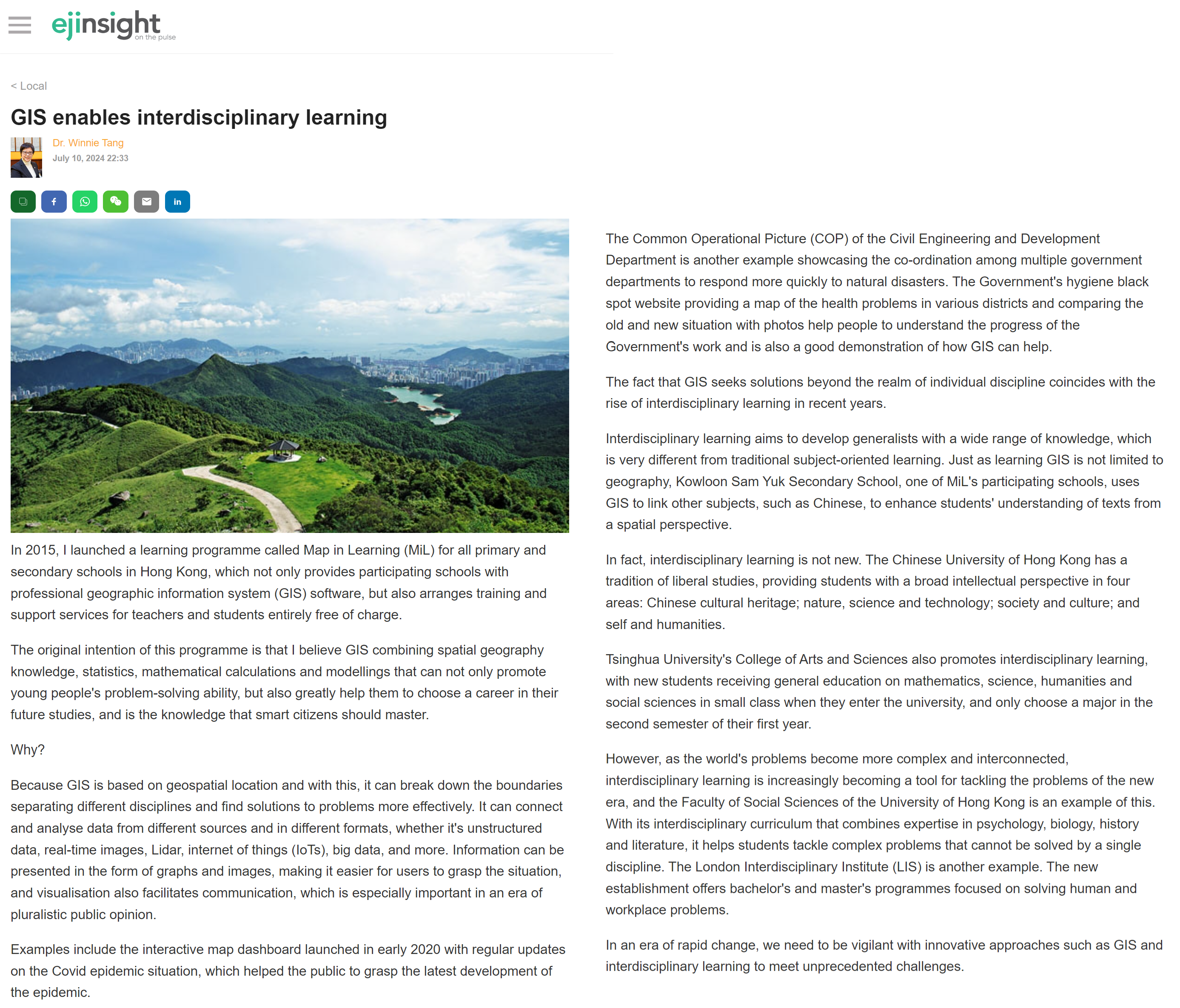網上版請按此

GIS enables interdisciplinary learning
In 2015, I launched a learning programme called Map in Learning (MiL) for all primary and secondary schools in Hong Kong, which not only provides participating schools with professional geographic information system (GIS) software, but also arranges training and support services for teachers and students entirely free of charge.
The original intention of this programme is that I believe GIS combining spatial geography knowledge, statistics, mathematical calculations and modellings that can not only promote young people's problem-solving ability, but also greatly help them to choose a career in their future studies, and is the knowledge that smart citizens should master.
Why?
Because GIS is based on geospatial location and with this, it can break down the boundaries separating different disciplines and find solutions to problems more effectively. It can connect and analyse data from different sources and in different formats, whether it's unstructured data, real-time images, Lidar, internet of things (IoTs), big data, and more. Information can be presented in the form of graphs and images, making it easier for users to grasp the situation, and visualisation also facilitates communication, which is especially important in an era of pluralistic public opinion.
Examples include the interactive map dashboard launched in early 2020 with regular updates on the Covid epidemic situation, which helped the public to grasp the latest development of the epidemic.
The Common Operational Picture (COP) of the Civil Engineering and Development Department is another example showcasing the co-ordination among multiple government departments to respond more quickly to natural disasters. The Government's hygiene black spot website providing a map of the health problems in various districts and comparing the old and new situation with photos help people to understand the progress of the Government's work and is also a good demonstration of how GIS can help.
The fact that GIS seeks solutions beyond the realm of individual discipline coincides with the rise of interdisciplinary learning in recent years.
Interdisciplinary learning aims to develop generalists with a wide range of knowledge, which is very different from traditional subject-oriented learning. Just as learning GIS is not limited to geography, Kowloon Sam Yuk Secondary School, one of MiL's participating schools, uses GIS to link other subjects, such as Chinese, to enhance students' understanding of texts from a spatial perspective.
In fact, interdisciplinary learning is not new. The Chinese University of Hong Kong has a tradition of liberal studies, providing students with a broad intellectual perspective in four areas: Chinese cultural heritage; nature, science and technology; society and culture; and self and humanities.
Tsinghua University's College of Arts and Sciences also promotes interdisciplinary learning, with new students receiving general education on mathematics, science, humanities and social sciences in small class when they enter the university, and only choose a major in the second semester of their first year.
However, as the world's problems become more complex and interconnected, interdisciplinary learning is increasingly becoming a tool for tackling the problems of the new era, and the Faculty of Social Sciences of the University of Hong Kong is an example of this. With its interdisciplinary curriculum that combines expertise in psychology, biology, history and literature, it helps students tackle complex problems that cannot be solved by a single discipline. The London Interdisciplinary Institute (LIS) is another example. The new establishment offers bachelor's and master's programmes focused on solving human and workplace problems.
In an era of rapid change, we need to be vigilant with innovative approaches such as GIS and interdisciplinary learning to meet unprecedented challenges.
Dr. Winnie Tang
Adjunct Professor, Department of Computer Science, Faculty of Engineering; Department of Geography, Faculty of Social Sciences; and Faculty of Architecture, The University of Hong Kong